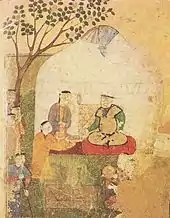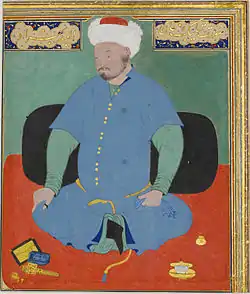Shaybanids
The Shaybanids (Persian: سلسله شیبانیان) were a Persianized[1] Turko-Mongol dynasty[2] in Central Asia.[3] They were the patrilineal descendants of Shiban, the fifth son of Jochi and grandson of Genghis Khan.[4] Until the mid-14th century, they acknowledged the authority of the descendants of Shiban's brothers Batu Khan and Orda Khan, such as Öz Beg Khan. The Shaybanids originally led the grey horde southeast of the Urals (also known as the Uzbegs, after the Uzbeks), and converted to Islam in 1282. At its height, the khanate included parts of modern-day Afghanistan and other parts of Central Asia.

As the lineages of Batu and Orda died out in the course of the great civil wars of the 14th century, the Shaybanids under Abu'l-Khayr Khan declared themselves the only legitimate successors to Jochi and put forward claims to the whole of his enormous ulus, which included parts of Siberia and Kazakhstan. Their rivals were the Tukay-Timurid dynasty, who claimed descent from Jochi's thirteenth son by a concubine. Several decades of strife left the Tukay-Timurids in control of the Great Horde and its successor states in Europe, namely the Khanates of Kazan, Astrakhan, and Crimea.
Shaybanid dynasty
Under Abu'l-Khayr Khan (who led the Shaybanids from 1428 to 1468), the dynasty began consolidating disparate Ozbeg (Uzbek) tribes, first in the area around Tyumen and the Tura River and then down into the Syr Darya region. His grandson Muhammad Shaybani (ruled 1500-10), who gave his name to the Shaybanid dynasty, conquered Samarkand, Herat,[4] Balkh[4] and Bukhara,[4] thus ending the Timurid dynasty and establishing the short-lived Shaybanid Empire.[5] After his death at the hands of Shah Ismail I, he was followed successively by an uncle, a cousin, and a brother, whose Shaybanid descendants would rule the Khanate of Bukhara from 1505 until 1598 and the Khanate of Khwarezm (Khiva) from 1511 until 1695.
Another state ruled by the Shaybanids was the Khanate of Sibir, seizing the throne in 1563. Its last khan, Kuchum, was deposed by the Russians in 1598. He escaped to Bukhara, but his sons and grandsons were taken by the Tsar to Moscow, where they eventually assumed the surname of Sibirsky.
Khans of Shaybanid dynasty of Khanate of Bukhara
| Titular Name | Personal Name | Reign |
|---|---|---|
| They were the descendants of Shiban, fifth son of Jochi ruling in Western Siberia. Later a major faction split and made a dash for Transoxiana and adopted the name Uzbek (Ozbeg) after their famous Khan, Uzbeg Khan. The faction that remained behind in Siberia created the Khanate of Sibir and lasted until the 16th century. | ||
| Khan خان |
Abul-Khayr Khan ibn Dawlat Shaykh ibn Ibrahim Khan ابو الخیر خان ابن دولت شیخ ابن ابراهیم خان |
1428 - 1468 C.E. |
| Khan خان Shaykh Hayder - |
Shah Budagh Khan ibn Abul-Khayr Khan شاه بداغ خان ابن ابو الخیر خان |
1468 C.E. |
| Khan خان Abul-Fath ابو الفتح |
Muhammad Shayabak Khan ibn Shah Budagh Khan ibn Abul-Khayr Khan محمد شایبک خان ابن شاہ بداغ خان ابن ابو الخیر خان |
1500 – 1510 C.E. |
| Khan خان |
Kochkunju Muhammad bin Abul-Khayr Khan کچھکنجو محمد بن ابو الخیر خان |
1512 – 1531 C.E. |
| Khan خان Muzaffar-al-Din مظفر الدین |
Abu Sa'id bin Kochkunju ابو سعید بن کچھکنجو |
1531 – 1534 C.E. |
| Khan خان Abul Ghazi ابو الغازی |
Ubaydullah bin Mahmud bin Shah Budagh عبید الله بن محمود بن شاه بداغ |
1534 – 1539 C.E. |
| Khan خان |
Abdullah bin Kochkunju عبد الله بن کچھکنجو |
1539 – 1540 C.E. |
| Khan خان |
Abdal-Latif bin Kochkunju عبد اللطیف بن کچھکنجو |
1540 – 1552 C.E. |
| Khan خان |
Nawruz Ahmed bin Sunjuq bin Abul-Khayr Khan نوروز احمد بن سنجق بن ابو الخیر خان |
1552 – 1556 C.E. |
| Khan خان |
Pir Muhammad Khan bin Jani Beg پیر محمد خان بن جانی بیگ |
1556 – 1561 C.E. |
| Khan خان |
Iskander bin Jani Beg اسکندر بن جانی بیگ |
1561 – 1583 C.E. |
| Khan خان Buzurg Khan بزرگ خان Abdullah Khan Uzbek عبد الله خان ازبک |
Abdullah Khan bin Iskander عبد الله خان بن اسکندر |
1583 – 1598 C.E. |
| Khan خان |
Abdul-Mo'min bin Abdullah Khan عبد المومن بن عبد الله خان |
1598 C.E. |
| Khan خان |
Pir Muhammad Khan bin Sulayman Khan bin Jani Beg پیر محمد خان بن سلیمان خان بن جانی بیگ |
1598 – 1599 C.E. |
| Khanate of Bukhara taken over by a new dynasty called the Janids also known as Toqay-Temurids (descendants of Khans of Astrakhan). | ||
- Blue Row Signifies progenitor chief.
- Khans of significance highlighted in Bold.
- Blue Row Signifies progenitor chief.
Notes
- Introduction: The Turko-Persian tradition, Robert L. Canfield, Turko-Persia in Historical Perspective, ed. Robert L. Canfield, (Cambridge University Press, 1999), 19.
- Shibanids, R.D. McChesney, The Encyclopaedia of Islam, Vol. IX, ed. C. E. Bosworth, E. Van Donzel, W. P. Heinrichs AND G. Lecomte, (Brill, 1986), 428;"SHIBANIDS, a Mongol dynasty of Central Asia, the agnatic descendants of Shiban, the fifth son of Djoci son of Cinggis Khan".
- Rene Grousset, The Empire of the Steppes, transl. Naomi Walford, (Rutgers University Press, 1970), 478.
- Svat Soucek, A History of Inner Asia, (Cambridge University Press, 2000), 149.
References
- Bartold, Vasily (1964) The Shaybanids. Collected Works, vol. 2, part 2. Moscow, 1964.
- Grousset, René (1970) The Empire of the Steppes: a history of central Asia Rutgers University Press, New Brunswick, NJ, (translated by Naomi Walford from the French edition, published by Payot in 1970), pp. 478–490 et passim, ISBN 0-8135-0627-1
- Bosworth, C.E. (1996) The new Islamic dynasties: a chronological and genealogical manual Columbia University Press, New York, pp. 288–9, ISBN 0-231-10714-5
- Soucek, Svatopluk (2000) A History of Inner Asia Cambridge University Press, Cambridge, pp. 149–157, ISBN 0-521-65169-7
- Erkinov A. “The Poetry of the Nomads and Shaybani Rulers of Transition to a Settled Society”. In: Central Asia on Display: Proceedings of the VII. Conference of the European Society for Central Asian Studies (27–30 September 2000). G.Rasuly-Paleczek, J. Katsching (eds). Vienna, 2005. P.145-150.
